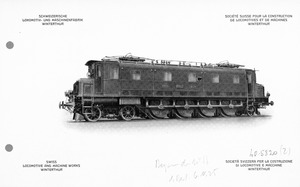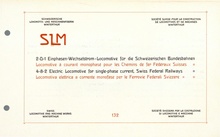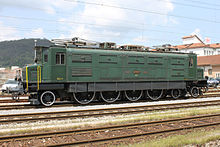SBB Ae 4/7
| SBB Ae 4/7 | |
|---|---|
|
SBB Ae 4/7
|
|
| Numbering: | 10901-11027 |
| Number: | 127 |
| Manufacturer: | SLM Winterthur, BBC Baden, MFO Zurich, SAAS Genève |
| Year of construction (s): | 1927-1934 |
| Retirement: | 1994-1996 |
| Axis formula : | 2'Do1 ' |
| Length over buffers: | 16,760 mm |
| Height: | 3800 mm |
| Width: | 2950 mm |
| Service mass: | 118-123 tons |
| Top speed: | 100 km / h |
| Continuous output : | 2300 kW (3120 hp ) |
| Drive: | Buchli drive |
The Ae 4/7 is a universal locomotive of the Swiss Federal Railways (SBB) with the so-called Buchli drive .
Not least thanks to the Buchli drive designed by Jakob Buchli , it was one of the longest-lasting locomotives. For seven decades, from the 1920s to the 1990s, it pulled passenger and freight trains in Switzerland .
prehistory
For the lowlands - which corresponds to gradients of up to twelve per thousand on the route - more powerful locomotives were needed in the 1920s . The existing locomotives with three drive axles were a little underperforming on gradients. Since the previous Ae 3/6 I and the Buchli drive used there had been good experiences, SBB ordered two prototypes of the Ae 4/7 in 1925 . A total of 127 Ae 4/7 were then delivered between 1927 and 1934.
construction
While the mechanical part was produced by the SLM, there were three sub-types for the electrical construction, as each was a series from Brown Boveri & Co. (BBC) (10901-10916, 10932-10938, 10952-10972, 11003-11008 and 11018–11027), the Maschinenfabrik Oerlikon (MFO) (10917–10918 and 10973–11002) and the Société anonyme Ateliers de Sécheron (SAAS) (10939–10951 and 11109–11017). The locomotives 10919-10931 were built by MFO, but equipped with BBC tap changers.
mechanical construction
The locomotive has four driving axles and three running axles . There is a single drive motor for each drive axle. The torque of the motors is transmitted to the axles in the proven Buchli drive. It is characteristic of the Buchli drive that the wheels are completely covered on one half of the locomotive, the drive side, and freely visible on the other, the apparatus side.
The locomotives were painted green - so-called SBB green.
On the side with the transformer - directly behind the driver's cab I - a two-axle running bogie was mounted, on the other hand a Bissel axle . The four drive axles are rigidly mounted. The middle two drive axles have therefore been given a larger side clearance for cornering. Originally the locomotives 10901, 10913-10933 and 10943-11017 were equipped with a so-called Java frame , i. i.e. they had the 2'Co (A1 ') wheel arrangement.
With the exception of the additional drive axle, the Ae 4/7 is similar in appearance and construction to the Ae 3/6 I series , but has also undergone significant further developments in the electrical part.
Electric Construction
As mentioned at the beginning, there are three variants of the electrical construction. The MFO locomotives were given a very fast hopping control . In contrast to the MFO hopper control, the SAAS hopper control could not be activated at any speed. The inhibitor limited the locking speed. The BBC locomotives, on the other hand, had a flat step switch .
The second series of MFO locomotives has an electric brake. The SAAS locomotives were equipped with multiple controls from 1963 , the others had no multiple controls for their entire lives.
Operational use
With the start of delivery, the Ae 4/7 were used on express trains throughout Switzerland. In 1930 they also took over the express train service over the Gotthard. They were to be found everywhere as universal locomotives.
In the 1940s , they were slightly harassed in flatland traffic by the Re 4/4 I. At the end of the 1950s , the Ae 4/7 was withdrawn from the Gotthard, as the Ae 6/6 took over this prestigious task. In 1960 four Ae 4/7 (10948-10951) received an ÖBB pantograph so that they could pull international trains on the St. Margrethen - Bregenz - Lindau route .
At the end of the 1960s , they were pushed back by the newly used Re 4/4 II for express train services . With the installation of the multiple control, the Ae 4/7 also took over heavy freight transport from now on.
Ae 4/7 that were not multi- controlled mainly pulled regional trains and light freight trains. In 1993 , 66 years after their first delivery, they were to be found on regional trains, mainly in eastern Switzerland. You could see them before certain express trains. The Ae 4/7 was even assigned the UIC numbers Ae 497 000-027 and 497 901-999 with a view to its use beyond the turn of the millennium (when the 12-digit TSI number was introduced in 2016, the still operational Ae 4/7 but then a number according to the pattern 91 85 4 401 xxx-x).
Scrapping
The first locomotive in this series was retired in 1983 due to its poor condition . In 1990 over 100 of the original 127 were still in operation. On January 1, 1995 there were 72 locomotives. The actual scrapping began in 1995 - surprising for many connoisseurs, as the SBB certified at the beginning of the 1990s that they would continue to operate well into the year 2000 . With the use of the Re 460 there were more locomotives than necessary, so that the Ae 4/7 became redundant. A year later they were all scrapped and many of them had already been dismantled. The last scheduled use of an Ae 4/7 for the SBB was in 1996 with a freight train service.
Whereabouts
The locomotives with the numbers 10905 (Rorschach depot) and 10976 (Lausanne depot) have been preserved by the SBB as operational, historic vehicles and are now owned by the SBB Historic Heritage Foundation (SBB Historic). Around 18 machines in all three electrical versions (BBC, MFO, SAAS) were sent to various private individuals who are part of the Swisstrain association . Most of these locomotives are inoperable. For example, the 10951 is on a siding at Sulgen train station in the canton of Thurgau.
In January and February 2007, two Ae 4/7, the 10950, built in 1931, and the 11010, built in 1932, were reactivated and were re-registered on the Swiss rail network after a train control system was installed. They have been doing commercial services for Rail4chem since February 28, 2008 , but so far there seems to have only been one assignment.
The 10997 locomotive belongs to Serge Bourguinet and Sven Mafli, who offer cab rides on the Gotthard with this locomotive.
lifespan
The Ae 4/7 were in operation with the SBB from 1927 to 1996 , i.e. for 69 years. So far, they have only been surpassed for main-line locomotives by the machines of the previous series Ae 3/6 I , which ran between 1921 and 1994 , i.e. 73 years.
Accidents
On September 25, 1941, Ae 4/7 number 10984 was badly damaged when it derailed near the Veytaux-Chillon station. The trigger was a mine explosion in the Chillon lock , which claimed seven lives and derailed the 5415 freight train (whose locomotive it was).
gallery
See also
literature
- The electric and diesel traction vehicles of the SBB. Volume 1: Hans Schneeberger: years of construction 1904–1955. Minirex, Luzern 1995, ISBN 3-907014-07-3 .
- Fritz Steiner: The new Ae 4/7 locomotives of the SBB In: Schweizerische Bauzeitung . Vol. 89, No. 26, 1927, pp. 341-345, ( digitized version (PDF; 4.55 MB) ).
Web links
Individual evidence
- ↑ Swiss Railway Review, 4/2008, p. 158
- ↑ Ae 4/7 for RAIL4CHEM left Winterthur after completion of the renovation - shut down again after 1st use. Bahnonline.ch, June 18, 2008, accessed on October 16, 2018 .
- ^ Claude Jeanmaire The electric and diesel traction vehicles of the Swiss railways; First part; The Swiss Federal Railways (SBB), representation of the locomotives driving cars, shunting locomotives and tractors 1970 page 110









